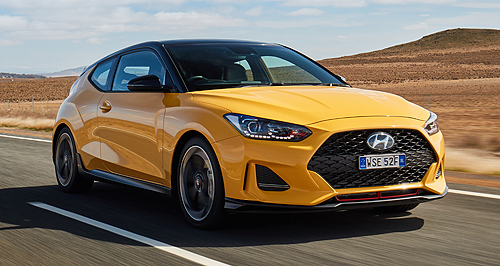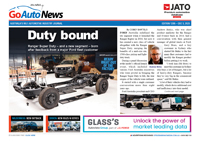Make / Model Search
New models - Hyundai - Veloster - rangeDriven: All-new Hyundai Veloster touches downExpanded Veloster four-door hatch range to play brand builder for Hyundai in Australia27 Sep 2019 HYUNDAI Motor Company Australia (HMCA) has tempered sales expectations for its all-new, second-generation Veloster coupe-cum-hatch, which arrives in showrooms this month priced from $29,490 plus on-roads.
The South Korean car-maker is hopeful of recording around 2000 annual sales of its quirky, affordable sportscar, meaning it will not be able to reach the heights of its first-generation predecessor.
Its best sales year was in 2012, the year it arrived in Australia, with a total of 4107 new registrations. Each year up to 2016 reaped at least 2000 annual sales, with 1935 in 2017 marking the first time it slipped below 2000.
As a particularly niche vehicle, the Veloster does not have any direct competitors, however HMCA thinks it can lure sportscar, hatch and SUV buyers, and as such considers vehicles like the Toyota 86, Subaru BRZ, Mazda3 G25, Kia Cerato GT as well as the Toyota CH-R and Nissan Juke to be its competitors.
HMCA sees three types of buyers being attracted to the Veloster, namely 20 to 30-year-old first-time buyers, mostly female; middle-age professionals looking for something different; and older buyers where the Veloster will be the second car in the garage.
HMCA director of marketing Bill Thomas said that while the Veloster is not expected to be a big volume seller for the brand, it will help to shape Hyundai’s image away from a plain, value-focused brand to one that embraces interesting and different vehicles.
“I think we find that 63 per cent of people who are intending to buy a car in the next five years don’t attribute any attributes to Hyundai as a brand,” he said.
“That’s through some of the research we get across the industry. So they don’t really think that Hyundai stands for anything in particular. And that’s something that we need to shift.
“Veloster obviously plays a part in that, but I think we need to do a bigger job with brand image and brand equity going forward, and you’ll see that happening next year.
“But definitely Veloster has a role to play in that as a niche coupe, and the only coupe that we do.”
About 50 per cent of new Veloster sales are expected to consist of the more powerful 1.6-litre turbo engine, with around 40 per cent of those being the top-spec Turbo Premium grade.
The Veloster arrives in Australia some time after the model’s initial reveal at last year’s Detroit motor show in January due to production scheduling and also the fact that Australia is the only right-hand-drive market in the world to take the new sportscar.
Three model grades will be offered, starting with the entry-level Veloster manual from $29,490 plus on-road costs, up to the automatic Turbo Premium variant that tops the range at $41,990.
While entry to the range has come down by $100 over the outgoing version, the higher variants have moved a long way upstream, with the previous Veloster SR range-topper asking $33,150 – $8840 shy of the Turbo Premium.
The price bump has come as a result of a large increase in specification, with Turbo Premium variants enjoying the inclusion of a number of luxurious features not found in previous-generation versions.
Two engine choices are available for the Veloster, starting with the new 2.0-litre Atkinson cycle aspirated petrol engine that replaces the 1.6-litre engine in the previous range.
Peak power output is rated at 110kW at 6200rpm (up 7kW) with maximum torque of 180Nm at 4500rpm (up 12Nm), with drive sent the front wheels via either a six-speed manual or automatic transmission.
The 2.0-litre sips 7.0 litres per 100km on the combined cycle when teamed to the manual transmission (up 0.1L/100km for the auto), while official emissions are rated at 161-162 grams of CO2 per km.
Turbo and Turbo Premium variants share the carry-over 1.6-litre turbocharged four-cylinder engine from the previous-gen SR, which continues to pump out 150kW at 6000rpm and 265Nm from 1500-4500rpm.
An overboost function allows an extra 10Nm to be wrung from the engine during full-throttle acceleration and is only available once the engine has reached operating temperature.
Also driving the front wheels, the more powerful engine can be paired to a six-speed manual or seven-speed dual-clutch automatic.
Fuel consumption remains similar to the less powerful 2.0-litre at 7.3L/100km (manual) and 6.9L/100km (auto) while emitting 160-169g/CO2 per km.
Manual variants are offered with Normal and Sport driving modes, with automatic versions adding Eco and Smart modes.
Turbo engines with the dual-clutch auto also come with a Drive Sport mode, which is engaged when switching the transmission to manual mode and is used for short bursts where maximum engine response is required, such as when overtaking.
Based on the same platform as the i30 and Elantra small cars, the new Veloster has increased structural rigidity by 27.6 per cent over its predecessor, thanks to improvements to body structure, 30 times more structural adhesive than the old model and the use of hot-stamped components such as on the A-pillars and side sills.
Along with the greater stiffness, sporty handling has also been improved with the inclusion of a multi-link rear suspension set-up, which replaces the old torsion beam on the first-gen Veloster.
This combines with MacPherson-strut front suspension to improve high-speed stability, ride comfort and cornering ability.
Like every Australian Hyundai offering bar the iLoad and iMax, the Veloster comes with a locally tuned spring and damper calibration to help with this country’s less-than-ideal road surfaces.
Testing 15 different front and 28 rear damper iterations, engineers were able to use the learnings from the i30’s suspension calibration as the two models utilising similar components.
With a new exterior design, Hyundai engineers have enhanced the Veloster’s design with functional air curtains that reduce turbulence caused by the wheels, and underbody components that reduce drag underneath the vehicle.
The entry-level Veloster grade with the 2.0-litre engine comes as standard with equipment including 18-inch alloy wheels wrapped in Michelin Pilot Sport 3 rubber, automatic dusk-sensing headlights, LED daytime running lights, cloth upholstery, z six-speaker audio system and a 7.0-inch touchscreen display with Apple CarPlay/Android Auto compatibility and Hyundai Auto Link.
Stepping up to the Turbo bundles in LED headlights and tail-lights, sports side skirts with Turbo badging, Michelin Pilot Sport 4 tyres, alloy sports pedals, cloth and leather-appointed seats, digital performance gauges, paddle-shifters, an eight-speaker Infinity audio system, keyless entry and start, a 4.2-inch digital instrument cluster and an 8.0-inch infotainment system with DAB+ digital radio and satellite navigation.
The top-spec Turbo Premium adds five-spoke dark metallic wheels with a red centre cap, a full-width glass sunroof, rain-sensing wipers, an eight-way power-adjustable driver’s seat, an auto-dimming rearview mirror, heated and ventilated front seats, a heated steering wheel, leather upholstery, a head-up display and Qi wireless smartphone charging.
Standard safety equipment across the range extends to forward collision warning, lane-keep assist, driver attention alert, tyre pressure monitoring, rear parking sensors and a rearview camera with dynamic guide lines.
Turbo variants also score blind-spot collision warning, high-beam assist, rear cross-traffic alert, forward collision-avoidance assist with camera and radar, and adaptive cruise control. The last two features are only available with the dual-clutch transmission.
Seven exterior colours are available, with the Turbo Premium also offered with a black two-tone roof option.
2019 Hyundai Veloster pricing*
*Excludes on-road costs  Quick testsRead more5th of September 2019  Hyundai releases new Veloster pricingEntry-level pricing down slightly but Turbo cost way up in fresh Hyundai Veloster16th of January 2018  Detroit show: Hyundai’s new Veloster surfacesNew-gen Hyundai Veloster range expected in Aussie showrooms second half 2018All new modelsVeloster pricingMotor industry news |
|




 Alfa Romeo
Alfa Romeo Abarth
Abarth Audi
Audi Aston Martin
Aston Martin BMW
BMW Bentley
Bentley Ferrari
Ferrari Chevrolet
Chevrolet Ford
Ford Fiat
Fiat GWM
GWM Foton
Foton Hyundai
Hyundai Honda
Honda Jaguar
Jaguar Isuzu
Isuzu Kia
Kia Jeep
Jeep Land Rover
Land Rover Lamborghini
Lamborghini Maserati
Maserati Lexus
Lexus McLaren
McLaren Mazda
Mazda Mercedes-Benz
Mercedes-Benz Mitsubishi
Mitsubishi Mini
Mini Peugeot
Peugeot Nissan
Nissan Ram
Ram Porsche
Porsche Rolls-Royce
Rolls-Royce Smart
Smart Skoda
Skoda Suzuki
Suzuki Subaru
Subaru Toyota
Toyota Tesla
Tesla Volvo
Volvo Zeekr
Zeekr







Facebook Twitter Instagram